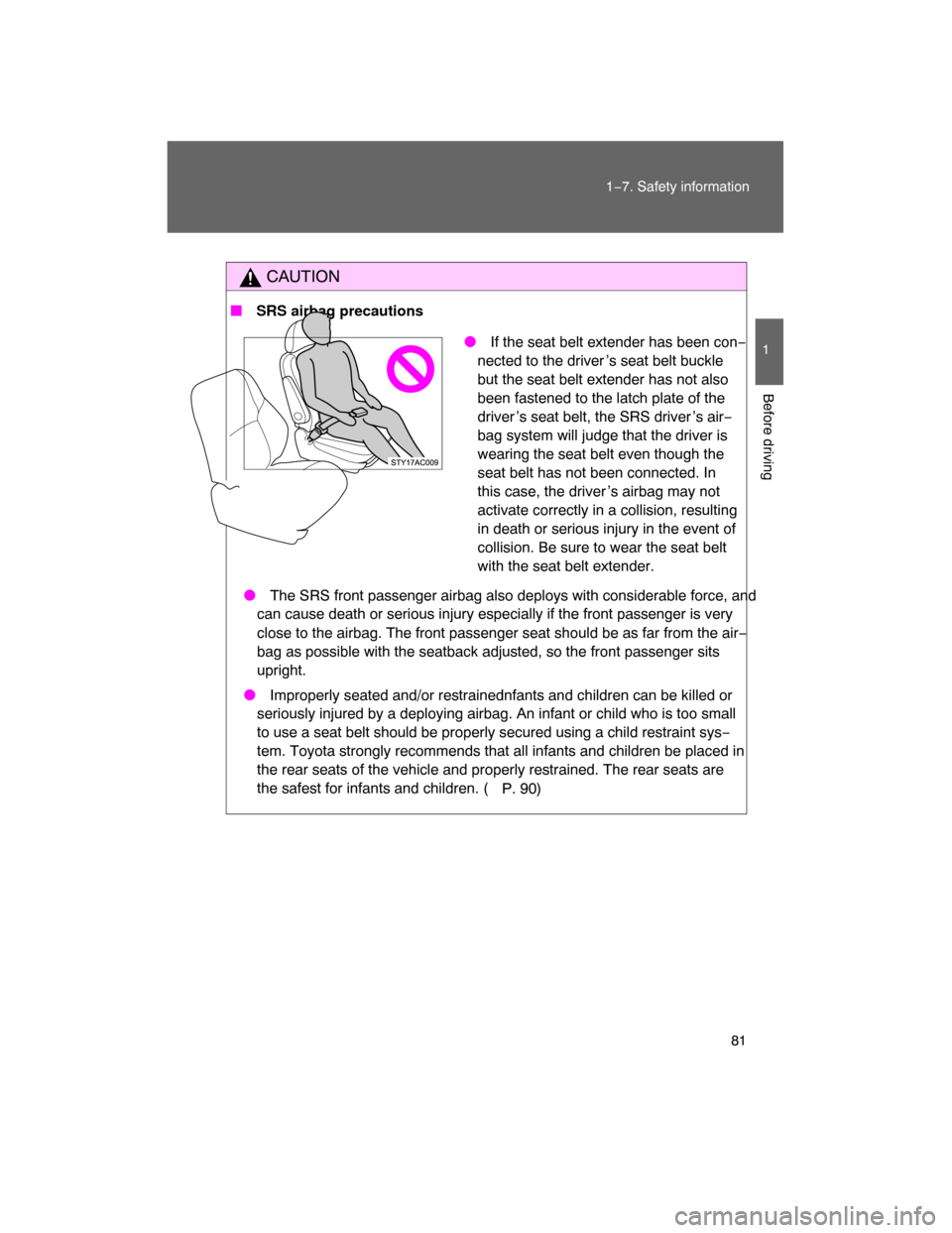Page 80 of 400

81
1−7. Safety information
1
Before driving
CAUTION
� SRS airbag precautions
� The SRS front passenger airbag also deploys with considerable force, and
can cause death or serious injury especially if the front passenger is very
close to the airbag. The front passenger seat should be as far from the air−
bag as possible with the seatback adjusted, so the front passenger sits
upright.
� Improperly seated and/or restrained
infants and children can be killed or
seriously injured by a deploying airbag. An infant or child who is too small
to use a seat belt should be properly secured using a child restraint sys−
tem. Toyota strongly recommends that all infants and children be placed in
the rear seats of the vehicle and properly restrained. The rear seats are
the safest for infants and children. (
P. 90)
� If the seat belt extender has been con−
nected to the driver ’s seat belt buckle
but the seat belt extender has not also
been fastened to the latch plate of the
driver ’s seat belt, the SRS driver ’s air−
bag system will judge that the driver is
wearing the seat belt even though the
seat belt has not been connected. In
this case, the driver ’s airbag may not
activate correctly in a collision, resulting
in death or serious injury in the event of
collision. Be sure to wear the seat belt
with the seat belt extender.
Page 83 of 400
84 1−7. Safety information
CAUTION
� Modification and disposal of SRS airbag system components
Do not dispose of your vehicle or perform any of the following modifications
without consulting your Toyota dealer.
The SRS airbags may malfunction or deploy (inflate) accidentally, causing
death or serious injury.
� Installation, removal, disassembly and repair of the SRS airbags.
�
Repairs, modifications, removal or replacement of the steering wheel,
instrument panel, dashboard, seats or seat upholstery, front and rear pil−
lars or roof side rails.
� Repairs or modifications of the front
fender, front bumper, or side of the
occupant compartment.
�Installation of snow plows, winches, etc. to the front grille (bull bars, kan−
garoo bar etc.).
� Modifications to the vehicle’s suspension system.
�Installation of electronic devices such as mobile two−way radios or CD
players.
� Modifications to your vehicle for a person with a physical disability.
Page 88 of 400

89
1−7. Safety information
1
Before driving
CAUTION
� Front passenger occupant classification system precautions
� If an adult sits in the front passenger seat, the AIR BAG ON indicator light
is illuminated. If the AIR BAG OFF indicator is illuminated, ask the passen−
ger to sit up straight, well back in the seat, feet on the floor, and with the
seat belt worn correctly. If the AIR BAG OFF indicator still remain illumi−
nated, either ask the passenger to move to the rear seat, or if that is not
possible, move the front passenger seat fully rearward.
� When it is unavoidable to install the forward−facing child restraint system
on the front passenger seat, install the child restraint system on the front
passenger seat in the proper order. (
P. 93)
� Do not modify or remove the front seats.
�Do not kick the front passenger seat or subject it to severe impact. Other−
wise, the SRS warning light may come on to indicate a malfunction of the
detection system. In this case, contact your Toyota dealer immediately.
� Child restraint systems installed on the rear seat should not contact the
front seatbacks.
Page 92 of 400
93
1
1−7. Safety information
Before driving
Installing child restraints
Follow the child restraint system manufacturer’s instructions. Firmly
secure child restraints to the outside rear seats using a seat belt or a
child restraint lower anch
or belt. Attach the top strap when installing
a child restraint.
Seat belts equipped with a
child restraint locking mecha−
nism (ALR/ELR belts except
driver ’s seat belt) ( P. 51)
Child restraint lower anchor−
ages
Lower anchorages are pro−
vided for the outside rear
seats. (Buttons displaying the
location of the anchorages are
attached to the seats.)
Anchor bracket (for top strap)
Anchor brackets are provided
for all rear seats.
Page 165 of 400

167
2−5. Driving information
2
When driving
CAUTION
�Things that must not be carried in the luggage compartment
The following things may cause a fire if loaded in the luggage compart−
ment.
�Receptacles containing gasoline
�Aerosol cans
�Storage precautions
�Do not stack anything in the luggage compartment higher than the
seatbacks.
Such items may be thrown about and possibly injure people in the
vehicle during sudden braking or in an accident.
�Do not drive with objects on top of the instrument panel.
They may interfere with the driver ’s field of view or move during sharp
acceleration or turning, thus impairing the driver ’s control of the vehi−
cle. In an accident they may injure the vehicle occupants.
�Secure all items in the occupant compartment, as they may shift and
injure someone during an accident or sudden braking.
�Never allow anyone to ride in the luggage compartment. It is not
designed for passengers. They should ride in their seats with their seat
belts properly fastened. Otherwise,
they are much more likely to suffer
death or serious bodily injury, in the event of sudden braking or a colli−
sion.
�Capacity and distribution
�Do not exceed the maximum axle weight rating or the total vehicle
weight rating.
�Even if the total load of occupant’s weight and the cargo load is less
than the total load capacity, do no t apply the load unevenly. Improper
loading may cause deterioration of st eering or braking control which
may cause death or serious injury.
Page 241 of 400

244 3−5. Other interior features
NOTICE
� To avoid damaging the power outlet and the plug
� Close the power outlet lid when not in use.
�Foreign objects or liquids that enter the power outlet may cause a short
circuit.
� Do not use plug adaptors to connect too many plugs to the power outlet.
�After inserting a plug, gently close the power outlet lid.
�To prevent the fuse from being blown
Do not use a 115V AC appliance that requires more than maximum capacity.
If a 115V AC appliance that consumes more than maximum capacity is
used, the protection circuit will cut the power supply.
� Appliances that may not operate properly (115V AC)
The following 115V AC appliances may not operate even if their power con−
sumption is under maximum capacity.
� Appliances with high initial peak wattage
�Measuring devices that process precise data.
�Other appliances that require an extremely stable power supply
�To prevent the battery from being discharged
Turn off all the vehicle’s electronic equipment and accessories, such as the
headlights and air conditioning, when elec trical appliances that consume in
excess of 100W are used continuously for long periods of time.
� To prevent any damage caused by heat
Do not use any electrical appliances that give off intense heat such as toast−
ers, in any locations including the internal or external trim, seats and deck.
� Do not use any electrical appliances, which are easily affected by vibration
or heat, inside the vehicle.
Vibration while driving, or the heat of the sun while parking, may result in
damage to those electrical appliances.
Page 262 of 400
266 4−2. Maintenance
Vehicle interior
Items Check points
Accelerator pedal�Moves smoothly (without uneven
pedal effort or catching)?
Automatic transmission “Park”
mechanism�Can the vehicle be hold securely
on an incline with the shift lever in
P?
Brake pedal�Moves smoothly?
�Does it have appropriate clear−
ance and correct amount of free
play?
Brakes�Not pull to one side when
applied?
�Loss of brake effectiveness?
�Spongy feeling brake pedal?
�Pedal almost touches floor?
Clutch pedal�Moves smoothly?
�Does it have correct amount of
free play?
Head restraints�Move smoothly and lock
securely?
Indicators/buzzers�Function properly?
Lights�Do all the lights come on?
�Headlights aimed correctly?
( P. 314)
Parking brake�Moves smoothly?
�Can hold the vehicle securely on
an incline?
Seat belts�Does the seat belt system oper−
ate smoothly?
�Are the belts undamaged?
Seats�Do the seat controls operate
properly?
Page 374 of 400

380 6−1. Specifications
Warning: The temperature grades for this tire are established for a
tire that is properly inflated and not overloaded.
Excessive speed, underinflation,
or excessive loading, either
separately or in combination, can cause heat buildup and possible
tire failure.
Glossary of tire terminology
Tire related term Meaning
Cold tire inflation
pressureTire pressure when the vehicle has been
parked for three hours or more, or has not
been driven more than 1 mile or 1.5 km under
that condition
Maximum inflation
pressureThe maximum cold inflated pressure to which a
tire may be inflated, shown on the sidewall of
the tire
Recommended
inflation pressureCold tire inflation pressure recommended by a
manufacturer
Accessory weightThe combined weight (in excess of those
standard items which may be replaced) of
transmission, power steering, power brakes,
power windows, power seats, radio and heater,
to the extent that these items are available as
factory−installed equipment (whether installed
or not)
Curb weightThe weight of a motor vehicle with standard
equipment, including the maximum capacity of
fuel, oil and coolant, and if so equipped, air
conditioning and additional weight optional
engine
Maximum loaded
vehicle weight
The sum of:
(a) Curb weight
(b) Accessory weight
(c) Vehicle capacity weight
(d) Production options weight